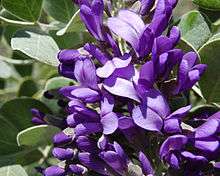Dermatophyllum secundiflorum
| Dermatophyllum secundiflorum | |
|---|---|
 | |
| Dermatophyllum secundiflorum flowers and leaves | |
| Scientific classification | |
| Kingdom: | Plantae |
| (unranked): | Angiosperms |
| (unranked): | Eudicots |
| (unranked): | Rosids |
| Order: | Fabales |
| Family: | Fabaceae |
| Genus: | Dermatophyllum |
| Species: | D. secundiflorum |
| Binomial name | |
| Dermatophyllum secundiflorum (Ortega) Gandhi & Reveal | |
 | |
| Natural range | |
| Synonyms[1] | |
| |
Dermatophyllum secundiflorum is a species of flowering shrub or small tree in the pea family, Fabaceae,[2] that is native to the southwestern United States (Texas, New Mexico) and Mexico (Chihuahua and Coahuila south to Hidalgo, Puebla and Querétaro).[3] Common names include Texas mountain laurel, Texas mescalbean, frijolito, and frijolillo.[2] Although "mescalbean" is among the plant's common appellations, it bears no relation to the Agave species used to make the spirit mezcal, nor to the peyote cactus (Lophophora williamsii), which contains the hallucinogenic alkaloid mescaline.[4]
It is well-adapted to arid and semi-arid habitats but is most common in riparian zones.[2]
An evergreen, its leaves are pinnately compound, with small, roughly spatulate leaflets; the leaflets are rather thick, and waxy to the touch. Never tall, and rarely having a straight trunk, its bark is smooth in all but the oldest specimens.[5] It grows slowly to a height of 15 ft (4.6 m) and a crown diameter of 10 ft (3.0 m).[6]
Extremely fragrant purple flowers, resembling the smell of grape soda, are produced in large clusters in March and April. They are followed by 4 in (10 cm) pods containing deep orange seeds.[6]
Uses
Dermatophyllum secundiflorum is a popular ornamental plant due to its showy flowers and orange seeds. The reddish wood it produces is potentially useful, but as yet has little commercial value.
Further adding to this is the fact that the beans were in fact once used by some Native American tribes as a hallucinogen, before being supplanted by peyote. This plant does not contain any mescaline, however; all parts of it are highly poisonous, due to the principal alkaloid cytisine, which is chemically related to nicotine.
References
- ↑ Gandhi KN, Vincent MA, Reveal JL (2011). "Dermatophyllum, the correct name for Calia (Fabaceae)" (PDF). Phytoneuron. 57: 1–4.
- 1 2 3 Uchytil, Ronald J. (1990). "Sophora secundiflora". Fire Effects Information System. United States Forest Service. Retrieved 2009-12-29.
- ↑ "Calia secundiflora (Ortega) Yakovlev". Germplasm Resources Information Network. United States Department of Agriculture. 2003-01-17. Retrieved 2009-12-29.
- ↑ "Mescal Bean & The Unrelated Peyote Cactus". Plants That Make You Loco. Wayne's World. Retrieved 2009-12-29.
- ↑ "Sophora secundiflora Texas mountain laurel". Arid Plant List. Pima County Home Horticulture. 2004-05-16. Retrieved 2009-12-29.
- 1 2 Mielke, Judy (1993). Native Plants for Southwestern Landscapes. University of Texas Press. p. 258. ISBN 978-0-292-75147-7.
External links
![]() Media related to Dermatophyllum secundiflorum at Wikimedia Commons
Media related to Dermatophyllum secundiflorum at Wikimedia Commons
![]() Data related to Dermatophyllum secundiflorum at Wikispecies
Data related to Dermatophyllum secundiflorum at Wikispecies
- "Sophora secundiflora" (PDF). Digital Representations of Tree Species Range Maps from "Atlas of United States Trees" by Elbert L. Little, Jr. (and other publications). United States Geological Survey.
- Erowid mescal vault (Accessed 2/26/06)
- Dermatophyllum secundiflorum (as Sophora secundiflora)
- NRCS: USDA Plants Profile Dermatophyllum secundiflorum (as Calia secundiflora)